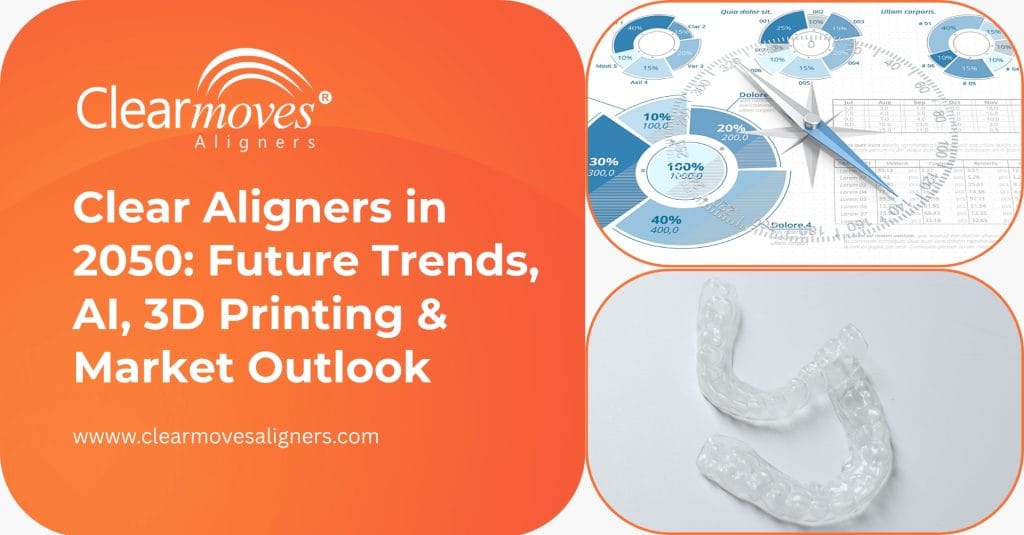
Digitally native care (AI-assisted diagnosis, digital twins, closed-loop monitoring),
Manufacturing shifts (direct 3D-printed aligners at chairside and in micro-factories), and
Regulatory and sustainability pressures (traceability, data governance, and low-waste materials).
Short-term evidence points to rapid growth through 2030 on the back of digital workflows and consumer preference for discreet treatments. Beyond that, outcomes depend on regulation, materials science, and access expansion.
The global clear aligner market will continue to grow with double-digit CAGR through ~2030, driven by adult demand, digital diagnostics, and broader provider adoption.
Because few datasets extend beyond 2034, it’s prudent to frame 2050 as scenarios rather than point forecasts:
High-adoption scenario: Direct-printed aligners (DPAs) become standard; AI reduces refinements and chair time; insurers expand coverage. Unit costs fall 30–50% from 2025 baselines; treatment starts expand in emerging markets.
Managed-growth scenario (most likely): Thermoformed and printed aligners coexist. AI planning and remote monitoring are ubiquitous; regulations tighten around DTC. Growth continues but moderates as markets mature.
Regulation-drag scenario: Data privacy, device rules, and environmental requirements increase costs; adoption in price-sensitive markets slows until sustainable materials and compliant workflows reach scale.
Structural demand drivers to 2050 include an ageing population and the persistent burden of oral diseases. By 2050, older adults will double to ~2.1 billion globally; malocclusion need remains high, sustaining adult orthodontics and pre-prosthetic alignment indications.
AI models will auto-segment dentitions, predict tooth/root movement against alveolar constraints, simulate periodontal risk, and propose force systems with minimal human adjustment.
Patients will have “digital twin” cases: continuous model updates from intra-oral scans and photos train predictive controllers that adjust staging and attachment design mid-treatment, reducing refinements.
Smartphone photogrammetry and low-profile intraoral sensors will enable adherence tracking (wear time, temperature) and early deviation alerts—flagging non-tracking before it compounds.
Direct 3D-printed aligners improve fit/adaptation, enable variable thickness and integrated features (bite ramps, elastic seats), and cut labor/waste by removing model printing, forming, trimming, and polishing. By 2050, most urban labs and many clinics will print aligners on-demand.
Thermoformed aligners won’t vanish; they’re clinically validated and may remain cost-effective in high-volume centers or where printed resins face regulatory or cost constraints.
By 2050, “micro-factories” (regional print hubs) will feed same-week starts in secondary cities, while large DSOs and premium clinics will operate chairside print for refinements and minor cases, compressing first-aligner delivery to 24–72 hours.
Resins & SMPs: Shape-memory polymers (SMPs) and printed photopolymers will yield programmable stiffness and time-dependent force delivery, reducing number of steps per case.
Antimicrobial & stain-resistant surfaces: Incorporation of safe, durable antimicrobial coatings and improved polishability to resist plaque and pigment.
Durability vs. clarity: 2050 materials will balance impact strength, creep resistance, and optical clarity to enable longer stage durations without compromising hygiene.
Direct-to-consumer models faced scrutiny in the 2020s; by 2050, the prevailing model is hybrid supervised—remote onboarding with mandatory diagnostics and periodic in-person exams for medical safety and data integrity. AI triage routes complex cases to specialists earlier, raising overall success rates and reducing refinements.
Device rules: Expect stricter evidence requirements for printed materials, lot traceability for each printed step, and post-market surveillance powered by anonymized treatment data.
AI rules: Planning software will be a regulated medical device with version control, bias audits, and mandated human oversight.
Tele-orthodontics: National laws will converge on “remote but supervised” frameworks, defining when scans suffice and when radiographs/CBCT are required.
Waste reduction: DPAs already remove model-printing, forming, and trimming waste; at scale this materially reduces plastic use per case.
Materials & recycling: By 2050, validated recycling streams for spent aligners, resin take-back programs, and lifecycle disclosures will be standard.
Reporting: Clinics and labs will report treatment CO₂e per case, pushed by procurement frameworks and insurers.
Ageing world: The share of older adults rises sharply through 2050; pre-prosthetic alignment, periodontal-friendly tooth movement, and minimally invasive aesthetics will keep adult demand robust.
Oral-disease burden: The persistent and rising burden of oral conditions will sustain a steady pipeline for interceptive and adult orthodontics.
Data moat: Millions of de-identified cases powering continuously improving AI planners.
Manufacturing agility: Multi-material printing, rapid validation, and automated QA.
Clinician experience: Seamless design tools, explainable AI, and one-click refinement protocols.
Compliance platform: Built-in remote monitoring with actionable nudges that correlate to endpoint predictability.
Sustainability & compliance: Verifiable chain of custody, recycling, and transparent AI/software change logs.
Regulatory whiplash: SaMD or resin bans can stall rollouts; keep contingency SKUs and validated alternates.
Data privacy constraints: Cross-border data transfer limits can fragment AI performance; invest in regionalized models.
Material breakthroughs lag: If printed resins don’t meet durability/clarity at cost, thermoforming retains share longer.
Macroeconomic pressure: Elective spend cycles can slow starts; insurer coverage and financing will buffer cycles.
Dual-track manufacturing: Run thermoform today; pilot DPAs in parallel. Validate force delivery and wear behavior in your indications.
Data discipline: Capture high-quality before/after, staging, refinement causes, and adherence signals; this becomes your AI flywheel.
Reg-ready AI stack: Treat planning software as SaMD now—version pinning, audit trails, human-in-the-loop checkpoints.
Sustainability roadmap: Quantify plastic/waste per case; trial resin/aligner take-back; publish ESG metrics relevant to dental procurement.
Access strategy: Design offerings for ageing patients and for emerging markets (financing + remote triage + regional print hubs).
The 2050 clear aligner landscape will be smarter, faster, cleaner—and more regulated. Practices and manufacturers that build AI-assisted planning, direct printing capability, rigorous compliance, and real sustainability into their operating system over the next five years will own the compounding advantages that define this market’s leaders by mid-century.
© 2025 Clear Moves Aligners All Rights Reserved